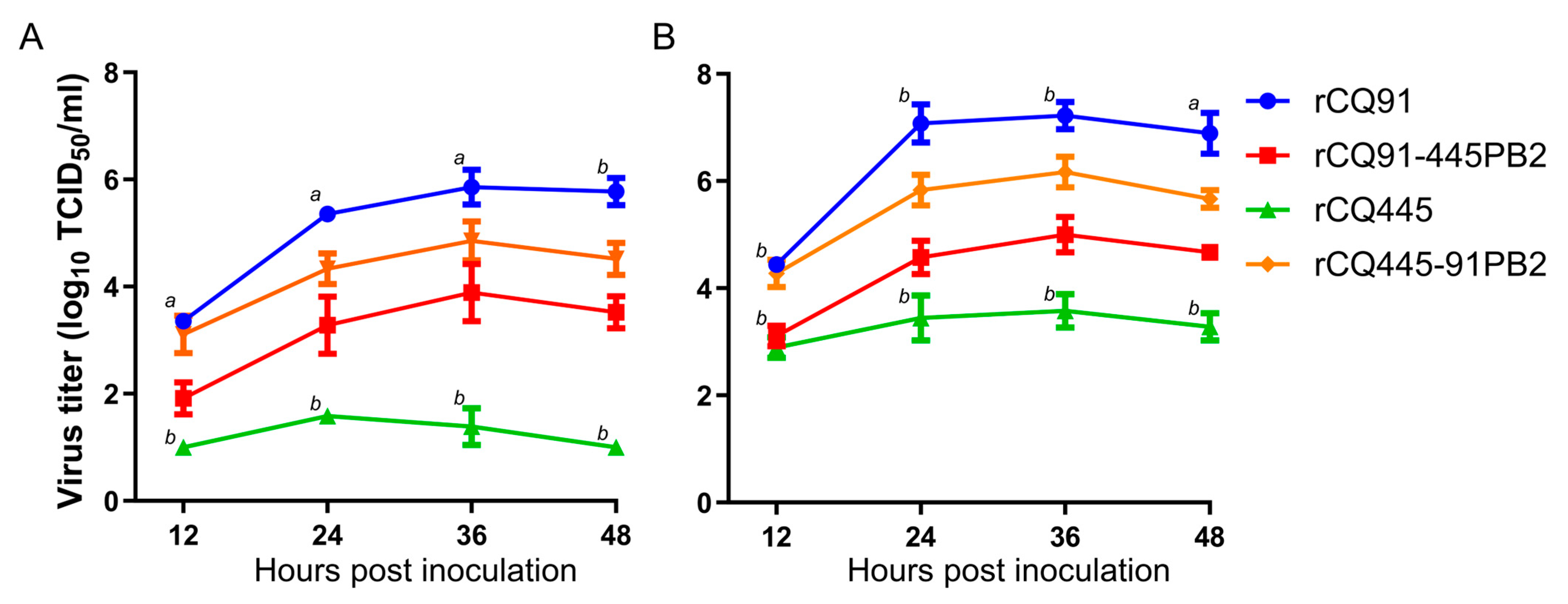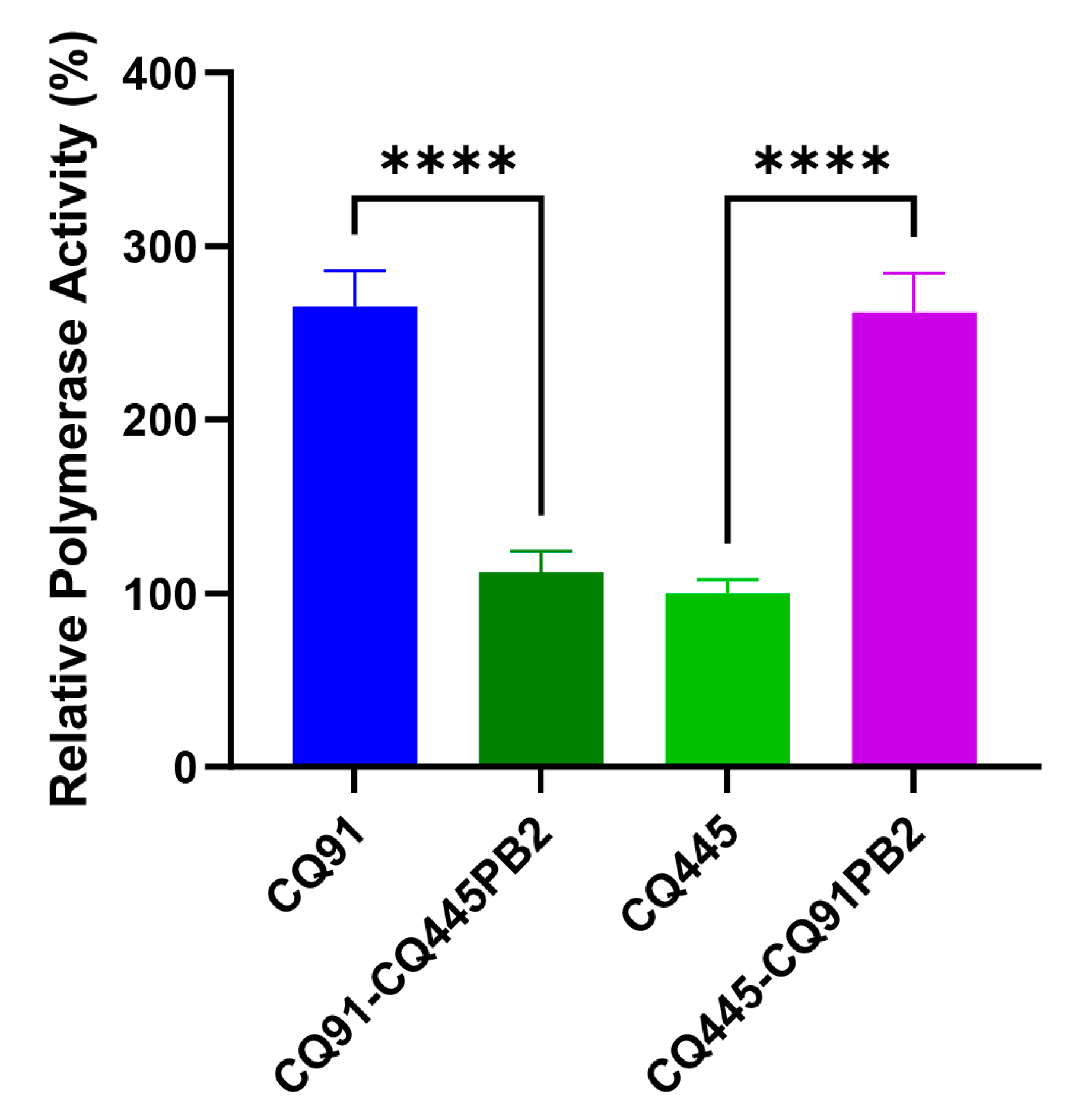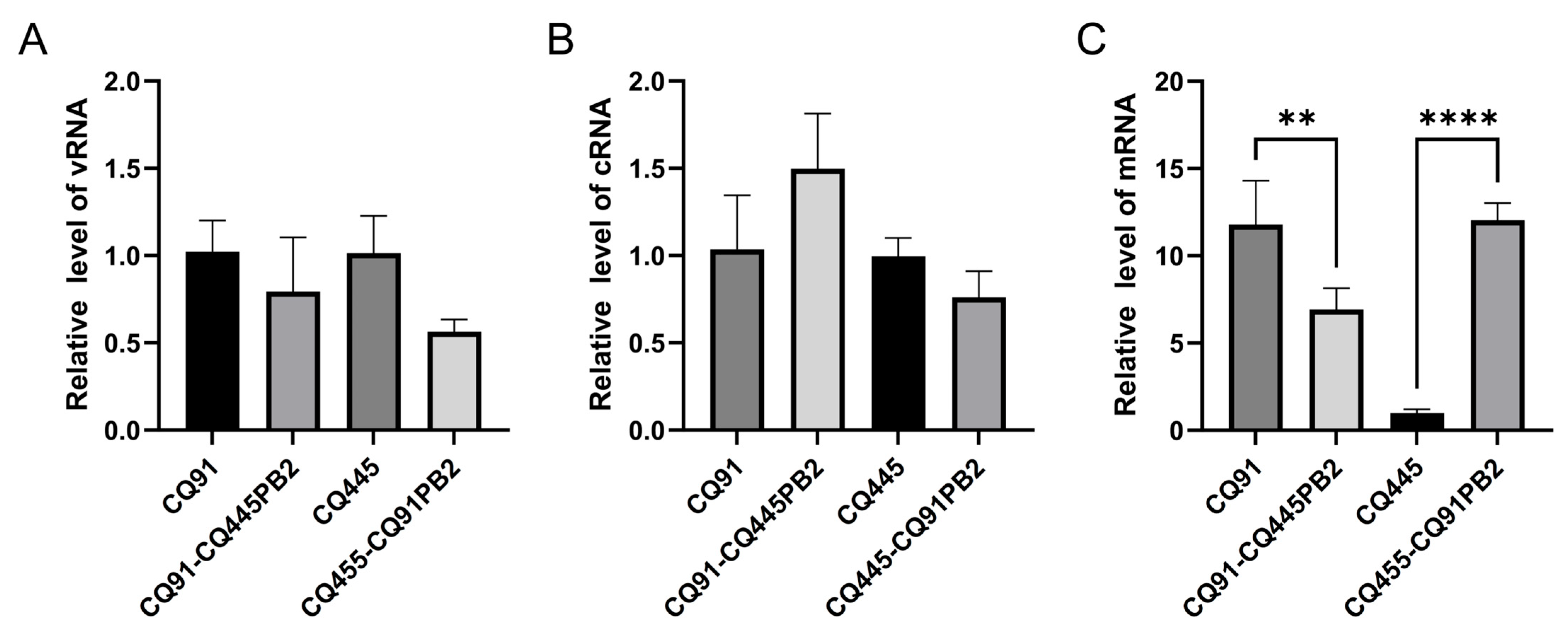Glutamic Acid at Position 343 in PB2 Contributes to the Virulence of H1N1 Swine Influenza Virus in Mice
Abstract
1. Introduction
2. Materials and Methods
2.1. Cells and Viruses
2.2. Sequence Analysis and Construction of Plasmids for Virus Rescue
2.3. Viral Replication in MDCK and A549 Cells
2.4. Mouse Experiments
2.5. Viral Minigenome Luciferase Assay
2.6. Quantitative Real-Time PCR (qRT-PCR) of vRNA, cRNA, and mRNA
2.7. Determination of the Effect of PB2-E343K Mutation on PB2 Structure
2.8. Statistical Analysis
3. Results
3.1. The Lysine at Position 343 in the PB2 Gene of the CQ445 Virus Attenuates the CQ91 Virus in Mice
3.2. The Amino Acid at Position 343 in the PB2 Protein Affects Viral Replication in MDCK and A549 Cells
3.3. PB2-K343E Mutation Increases CQ445 Polymerase Activity in 293T Cells
3.4. The Amino Acid at Position 343 in PB2 Affects the Transcription Stage of the Viral Replication Process
3.5. The Three-Dimensional Structure of the PB2-K343E Protein
3.6. PB2 Amino Acid 343E Is Dominant in H1 and H3 Subtypes of Human and Swine Influenza Viruses
4. Discussion
5. Conclusions
Supplementary Materials
Author Contributions
Funding
Institutional Review Board Statement
Informed Consent Statement
Data Availability Statement
Conflicts of Interest
References
- Henritzi, D.; Petric, P.P.; Lewis, N.S.; Graaf, A.; Pessia, A.; Starick, E.; Breithaupt, A.; Strebelow, G.; Luttermann, C.; Parker, L.M.K.; et al. Surveillance of European Domestic Pig Populations Identifies an Emerging Reservoir of Potentially Zoonotic Swine Influenza A Viruses. Cell Host Microbe 2020, 28, 614–627 e6. [Google Scholar] [CrossRef] [PubMed]
- Vijaykrishna, D.; Poon, L.L.; Zhu, H.C.; Ma, S.K.; Li, O.T.; Cheung, C.L.; Smith, G.J.; Peiris, J.S.; Guan, Y. Reassortment of pandemic H1N1/2009 influenza A virus in swine. Science 2010, 328, 1529. [Google Scholar] [CrossRef] [PubMed]
- Resende, P.C.; Born, P.S.; Matos, A.R.; Motta, F.C.; Caetano, B.C.; Debur, M.D.; Riediger, I.N.; Brown, D.; Siqueira, M.M. Whole-Genome Characterization of a Novel Human Influenza A(H1N2) Virus Variant, Brazil. Emerg. Infect. Dis. 2017, 23, 152–154. [Google Scholar] [CrossRef] [PubMed]
- Meng, F.; Chen, Y.; Song, Z.C.; Zhong, Q.; Zhang, Y.J.; Qiao, C.L.; Yan, C.; Kong, H.H.; Liu, L.L.; Li, C.J.; et al. Continued evolution of the Eurasian avian-like H1N1 swine influenza viruses in China. Sci. China-Life Sci. 2023, 66, 269–282. [Google Scholar] [CrossRef] [PubMed]
- Zhu, W.; Zhang, H.; Xiang, X.; Zhong, L.; Yang, L.; Guo, J.; Xie, Y.; Li, F.; Deng, Z.; Feng, H.; et al. Reassortant Eurasian Avian-Like Influenza A(H1N1) Virus from a Severely Ill Child, Hunan Province, China, 2015. Emerg. Infect. Dis. 2016, 22, 1930–1936. [Google Scholar] [CrossRef] [PubMed]
- Wang, D.Y.; Qi, S.X.; Li, X.Y.; Guo, J.F.; Tan, M.J.; Han, G.Y.; Liu, Y.F.; Lan, Y.; Yang, L.; Huang, W.J.; et al. Human infection with Eurasian avian-like influenza A(H1N1) virus, China. Emerg. Infect. Dis. 2013, 19, 1709–1711. [Google Scholar] [CrossRef] [PubMed]
- Xie, J.F.; Zhang, Y.H.; Zhao, L.; Xiu, W.Q.; Chen, H.B.; Lin, Q.; Weng, Y.W.; Zheng, K.C. Emergence of Eurasian Avian-Like Swine Influenza A (H1N1) Virus from an Adult Case in Fujian Province, China. Virol. Sin. 2018, 33, 282–286. [Google Scholar] [CrossRef] [PubMed]
- Li, X.; Guo, L.; Liu, C.; Cheng, Y.; Kong, M.; Yang, L.; Zhuang, Z.; Liu, J.; Zou, M.; Dong, X.; et al. Human infection with a novel reassortant Eurasian-avian lineage swine H1N1 virus in northern China. Emerg. Microbes Infect. 2019, 8, 1535–1545. [Google Scholar] [CrossRef] [PubMed]
- Meng, F.; Yang, H.; Qu, Z.; Chen, Y.; Zhang, Y.; Zhang, Y.; Liu, L.; Zeng, X.; Li, C.; Kawaoka, Y.; et al. A Eurasian avian-like H1N1 swine influenza reassortant virus became pathogenic and highly transmissible due to mutations in its PA gene. Proc. Natl. Acad. Sci. USA 2022, 119, e2203919119. [Google Scholar] [CrossRef] [PubMed]
- Hoffmann, E.; Stech, J.; Guan, Y.; Webster, R.G.; Perez, D.R. Universal primer set for the full-length amplification of all influenza A viruses. Arch. Virol. 2001, 146, 2275–2289. [Google Scholar] [CrossRef] [PubMed]
- Wang, Z.; Yang, H.L.; Chen, Y.; Tao, S.Y.; Liu, L.L.; Kong, H.H.; Ma, S.J.; Meng, F.; Suzuki, Y.; Qiao, C.L.; et al. A Single-Amino-Acid Substitution at Position 225 in Hemagglutinin Alters the Transmissibility of Eurasian Avian-Like H1N1 Swine Influenza Virus in Guinea Pigs. J. Virol. 2017, 91, 10-1128. [Google Scholar] [CrossRef] [PubMed]
- Xu, C.; Xu, B.; Wu, Y.; Yang, S.; Jia, Y.; Liang, W.; Yang, D.; He, L.; Zhu, W.; Chen, Y.; et al. A Single Amino Acid at Position 431 of the PB2 Protein Determines the Virulence of H1N1 Swine Influenza Viruses in Mice. J. Virol. 2020, 94, 10-1128. [Google Scholar] [CrossRef] [PubMed]
- Feng, X.; Wang, Z.; Shi, J.; Deng, G.; Kong, H.; Tao, S.; Li, C.; Liu, L.; Guan, Y.; Chen, H. Glycine at Position 622 in PB1 Contributes to the Virulence of H5N1 Avian Influenza Virus in Mice. J. Virol. 2016, 90, 1872–1879. [Google Scholar] [CrossRef] [PubMed]
- Reed, L.J.; Muench, H. A simple method of estimating fifty percent endpoints12. Am. J. Epidemiol. 1938, 27, 493–497. [Google Scholar] [CrossRef]
- Kesarwani, M.; Huber, E.; Kincaid, Z.; Evelyn, C.R.; Biesiada, J.; Rance, M.; Thapa, M.B.; Shah, N.P.; Meller, J.; Zheng, Y.; et al. Targeting substrate-site in Jak2 kinase prevents emergence of genetic resistance. Sci. Rep. 2015, 5, 14538. [Google Scholar] [CrossRef] [PubMed]
- Cazals, F.; Tetley, R. Characterizing molecular flexibility by combining least root mean square deviation measures. Proteins 2019, 87, 380–389. [Google Scholar] [CrossRef] [PubMed]
- Wang, Z.; Chen, Y.; Chen, H.; Meng, F.; Tao, S.; Ma, S.; Qiao, C.; Chen, H.; Yang, H. A single amino acid at position 158 in haemagglutinin affects the antigenic property of Eurasian avian-like H1N1 swine influenza viruses. Transbound. Emerg. Dis. 2022, 69, e236–e243. [Google Scholar] [CrossRef] [PubMed]
- Subbarao, E.K.; London, W.; Murphy, B.R. A single amino acid in the PB2 gene of influenza A virus is a determinant of host range. J. Virol. 1993, 67, 1761–1764. [Google Scholar] [CrossRef] [PubMed]
- Hatta, M.; Gao, P.; Halfmann, P.; Kawaoka, Y. Molecular basis for high virulence of Hong Kong H5N1 influenza A viruses. Science 2001, 293, 1840–1842. [Google Scholar] [CrossRef] [PubMed]
- Sun, H.; Xiao, Y.; Liu, J.; Wang, D.; Li, F.; Wang, C.; Li, C.; Zhu, J.; Song, J.; Sun, H.; et al. Prevalent Eurasian avian-like H1N1 swine influenza virus with 2009 pandemic viral genes facilitating human infection. Proc. Natl. Acad. Sci. USA 2020, 117, 17204–17210. [Google Scholar] [CrossRef] [PubMed]
- Wang, S.Y.; Wen, F.; Yu, L.X.; Wang, J.; Wang, M.Z.; Yan, J.C.; Zhou, Y.J.; Tong, W.; Shan, T.L.; Li, G.X.; et al. Potential Threats to Human Health from Eurasian Avian-Like Swine Influenza A(H1N1) Virus and Its Reassortants. Emerg. Infect. Dis. 2022, 28, 1489–1493. [Google Scholar] [CrossRef] [PubMed]
- Parys, A.; Vandoorn, E.; King, J.; Graaf, A.; Pohlmann, A.; Beer, M.; Harder, T.; Van Reeth, K. Human Infection with Eurasian Avian-Like Swine Influenza A(H1N1) Virus, the Netherlands, September 2019. Emerg. Infect. Dis. 2021, 27, 939–943. [Google Scholar] [CrossRef] [PubMed]
- de Jong, J.C.; Paccaud, M.F.; de Ronde-Verloop, F.M.; Huffels, N.H.; Verwei, C.; Weijers, T.F.; Bangma, P.J.; van Kregten, E.; Kerckhaert, J.A.; Wicki, F.; et al. Isolation of swine-like influenza A(H1N1) viruses from man in Switzerland and The Netherlands. Ann. Inst. Pasteur Virol. 1988, 139, 429–437. [Google Scholar] [CrossRef] [PubMed]
- He, Y.; Song, S.; Wu, J.; Wu, J.; Zhang, L.; Sun, L.; Li, Z.; Wang, X.; Kou, Z.; Liu, T. Emergence of Eurasian Avian-Like Swine Influenza A (H1N1) virus in a child in Shandong Province, China. BMC Infect. Dis. 2024, 24, 550. [Google Scholar] [CrossRef] [PubMed]
- Bussey, K.A.; Bousse, T.L.; Desmet, E.A.; Kim, B.; Takimoto, T. PB2 residue 271 plays a key role in enhanced polymerase activity of influenza A viruses in mammalian host cells. J. Virol. 2010, 84, 4395–4406. [Google Scholar] [CrossRef] [PubMed]
- Zhang, Y.; Zhang, Q.; Gao, Y.; He, X.; Kong, H.; Jiang, Y.; Guan, Y.; Xia, X.; Shu, Y.; Kawaoka, Y.; et al. Key molecular factors in hemagglutinin and PB2 contribute to efficient transmission of the 2009 H1N1 pandemic influenza virus. J. Virol. 2012, 86, 9666–9674. [Google Scholar] [CrossRef] [PubMed]
- Mehle, A.; Doudna, J.A. Adaptive strategies of the influenza virus polymerase for replication in humans. Proc. Natl. Acad. Sci. USA 2009, 106, 21312–21316. [Google Scholar] [CrossRef] [PubMed]
- Steel, J.; Lowen, A.C.; Mubareka, S.; Palese, P. Transmission of influenza virus in a mammalian host is increased by PB2 amino acids 627K or 627E/701N. PLoS Pathog. 2009, 5, e1000252. [Google Scholar] [CrossRef] [PubMed]
- Jagger, B.W.; Memoli, M.J.; Sheng, Z.M.; Qi, L.; Hrabal, R.J.; Allen, G.L.; Dugan, V.G.; Wang, R.; Digard, P.; Kash, J.C.; et al. The PB2-E627K mutation attenuates viruses containing the 2009 H1N1 influenza pandemic polymerase. Mbio 2010, 1, e00067-10. [Google Scholar] [CrossRef] [PubMed]
- Liu, Y.; Yang, Y.; Fan, J.; He, R.; Luo, M.; Zheng, X. The crystal structure of the PB2 cap-binding domain of influenza B virus reveals a novel cap recognition mechanism. J. Biol. Chem. 2015, 290, 9141–9149. [Google Scholar] [CrossRef] [PubMed]
- Guilligay, D.; Tarendeau, F.; Resa-Infante, P.; Coloma, R.; Crepin, T.; Sehr, P.; Lewis, J.; Ruigrok, R.W.; Ortin, J.; Hart, D.J.; et al. The structural basis for cap binding by influenza virus polymerase subunit PB2. Nat. Struct. Mol. Biol. 2008, 15, 500–506. [Google Scholar] [CrossRef] [PubMed]
- Tsurumura, T.; Qiu, H.; Yoshida, T.; Tsumori, Y.; Hatakeyama, D.; Kuzuhara, T.; Tsuge, H. Conformational polymorphism of m7GTP in crystal structure of the PB2 middle domain from human influenza A virus. PLoS ONE 2013, 8, e82020. [Google Scholar] [CrossRef] [PubMed]
- Li, H.; Wu, Y.; Li, M.; Guo, L.; Gao, Y.; Wang, Q.; Zhang, J.; Lai, Z.; Zhang, X.; Zhu, L.; et al. An intermediate state allows influenza polymerase to switch smoothly between transcription and replication cycles. Nat. Struct. Mol. Biol. 2023, 30, 1183–1192. [Google Scholar] [CrossRef] [PubMed]






| PB2-343E | PB2-343K | PB2-343 Other Residues | Total Number | |
|---|---|---|---|---|
| Human H1N1 | 54,348 | 3 | 38 | 54,389 |
| Human H3N2 | 77,007 | 0 | 28 | 77,035 |
| Swine H1N1 | 1858 | 1 | 0 | 1849 |
| Swine H1N2 | 1620 | 0 | 0 | 1620 |
| Swine H3N2 | 1256 | 0 | 0 | 1256 |
| Total | 136,089 | 4 | 66 | 136,149 |
Disclaimer/Publisher’s Note: The statements, opinions and data contained in all publications are solely those of the individual author(s) and contributor(s) and not of MDPI and/or the editor(s). MDPI and/or the editor(s) disclaim responsibility for any injury to people or property resulting from any ideas, methods, instructions or products referred to in the content. |
© 2025 by the authors. Licensee MDPI, Basel, Switzerland. This article is an open access article distributed under the terms and conditions of the Creative Commons Attribution (CC BY) license (https://creativecommons.org/licenses/by/4.0/).
Share and Cite
Wang, Y.; Zhong, Q.; Meng, F.; Cheng, Z.; Zhang, Y.; Song, Z.; Zhang, Y.; Feng, Z.; Zhai, Y.; Chen, Y.; et al. Glutamic Acid at Position 343 in PB2 Contributes to the Virulence of H1N1 Swine Influenza Virus in Mice. Viruses 2025, 17, 1018. https://doi.org/10.3390/v17071018
Wang Y, Zhong Q, Meng F, Cheng Z, Zhang Y, Song Z, Zhang Y, Feng Z, Zhai Y, Chen Y, et al. Glutamic Acid at Position 343 in PB2 Contributes to the Virulence of H1N1 Swine Influenza Virus in Mice. Viruses. 2025; 17(7):1018. https://doi.org/10.3390/v17071018
Chicago/Turabian StyleWang, Yanwen, Qiu Zhong, Fei Meng, Zhang Cheng, Yijie Zhang, Zuchen Song, Yali Zhang, Zijian Feng, Yujia Zhai, Yan Chen, and et al. 2025. "Glutamic Acid at Position 343 in PB2 Contributes to the Virulence of H1N1 Swine Influenza Virus in Mice" Viruses 17, no. 7: 1018. https://doi.org/10.3390/v17071018
APA StyleWang, Y., Zhong, Q., Meng, F., Cheng, Z., Zhang, Y., Song, Z., Zhang, Y., Feng, Z., Zhai, Y., Chen, Y., Qiao, C., & Yang, H. (2025). Glutamic Acid at Position 343 in PB2 Contributes to the Virulence of H1N1 Swine Influenza Virus in Mice. Viruses, 17(7), 1018. https://doi.org/10.3390/v17071018






